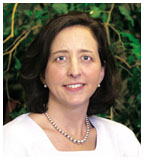Photo by Frank Wojciechowski |
Janet Rapelye
The first class admitted by Dean of Admission Janet Rapelye and her staff arrived on campus last month, and her office soon will begin reading applications for the Class of 2009. Few administrators are on the hot seat as much as Rapelye, who recently spoke about the future of admissions with PAW’s Brett Tomlinson.
You have said that you hope to “broaden and deepen” the applicant pool. What are you doing to accomplish that?
We’re trying to find every way to reach students as they come through their junior and senior years of high school. We write to the students who have done well on the PSATs and SATs. We’re starting to make sure that we reach out to students earlier, not necessarily to accelerate this process for them, but to make sure that they know about Princeton as early as they know about some of the other schools we’re competing against. We have a new e-mail site for the admissions office – students can write in electronically with their questions and we will answer them. We now have both the full application, as well as the common application, online. There’s a whole group of students who would not naturally think about Princeton, and we’re looking into ways to reach out to them.
How do you define diversity in admissions?
We define it very broadly. It includes racial and ethnic diversity. It also includes socioeconomic diversity, geographic diversity, and international diversity. It includes diversity in terms of background and beliefs; it includes diversity of talents.
Based on that definition, what groups are underrepresented at Princeton?
We try to get away from those terms and just talk about how we would like to build a multicultural campus. What is it going to take to build the most diverse class and the most diverse campus we can? I think there is a need to make sure that we have students from every background applying to Princeton so we can choose them. We can’t choose them if they’re not applying.
One recent criticism of selective universities has been that they lack socioeconomic diversity among students. What is Princeton doing to address this concern?
Because of how generous our financial aid policy is, we have a unique responsibility to find students from every socioeconomic background, perhaps especially from the lower socioeconomic backgrounds, where students and families might not even think of Princeton because our tuition and fees exceed their annual income. ... Very often the outside world doesn’t believe that we have no loan component. We have to convince them.
Several politicians, including President George W. Bush and Sen. John Edwards, have voiced opposition to legacy admissions. Does political pressure affect how Princeton approaches legacies?
No, and I hope that the government stays out of this issue. I think that this is something that private institutions can make their own decisions about. And yet I am well aware that we need to be responsible in our decisions and how we are admitting students. The quality of the sons and daughters who are applying to Princeton, and the fact that we are admitting them at a higher rate than the rest of the pool, puts us at about the right place at the moment. If we were to admit many more of those students, I think Princeton would stand out and be under greater public scrutiny. It’s not necessarily that we are under any pressure right now, but I do think we have a responsibility to be aware that there are those who are really watching us.
What do you tell alumni who ask about legacy admissions?
We admitted, over the entire pool last year, 12.6 percent of the applicants. Of the Princeton sons and daughters who applied, we admitted about 39 percent. To critics of the legacy admissions process, I can honestly say this is a strong, powerful group we would want at Princeton. But we did try this year to really pay attention to the sons and daughters of Princeton graduates. The qualifications of all of our admits are extremely high – higher than they were 20, 30, and 40 years ago – and I think that’s a surprise to some as families go through this process.
Beginning in 2007, you’ll have the opportunity to admit more students. What changes do you expect to see in those larger classes?
I don’t think that we’re looking at the 11 percent increase
to be in any one group. Certainly, we want to include students with talents
in music and art and theater, and certainly, we want to include students
who are from lower socioeconomic backgrounds. I think we want to find
students who are independent thinkers, who value intellectual curiosity.
And frankly, I don’t think that’s any different from what
Princeton has valued in the past. More than anywhere in the country, this
institution has valued intellectual curiosity. The expansion of the class
represents an expansion of thought, which is what higher learning is all
about. ![]()


